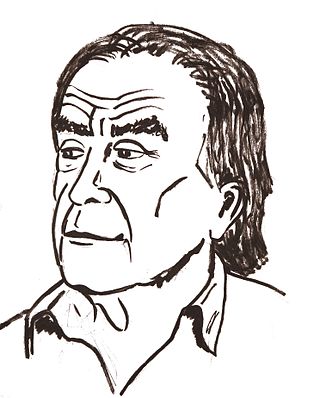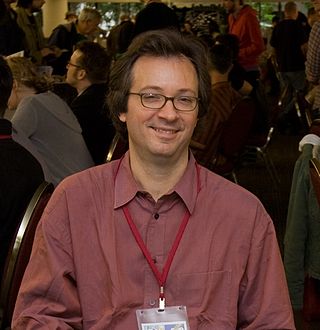
A cartoon is a type of visual art that is typically drawn, frequently animated, in an unrealistic or semi-realistic style. The specific meaning has evolved over time, but the modern usage usually refers to either: an image or series of images intended for satire, caricature, or humor; or a motion picture that relies on a sequence of illustrations for its animation. Someone who creates cartoons in the first sense is called a cartoonist, and in the second sense they are usually called an animator.

Sir David Alexander Cecil Low was a New Zealand political cartoonist and caricaturist who lived and worked in the United Kingdom for many years. Low was a self-taught cartoonist. Born in New Zealand, he worked in his native country before migrating to Sydney in 1911, and ultimately to London (1919), where he made his career and earned fame for his Colonel Blimp depictions and his satirising of the personalities and policies of German dictator Adolf Hitler, Italian dictator Benito Mussolini, Soviet leader Joseph Stalin, and other leaders of his times.

Steven William Maclean Bell is an English political cartoonist, whose work appears in The Guardian and other publications. He is known for his left-wing views.

Gerald Anthony Scarfe is an English cartoonist and illustrator. He has worked as editorial cartoonist for The Sunday Times and illustrator for The New Yorker.

Carlos Latuff is a Brazilian political cartoonist. His work deals with themes such as anti-Western sentiment, anti-capitalism, and opposition to U.S. military intervention. He is best known for his images depicting the Israeli–Palestinian conflict and the Arab Spring events.

The New Zealand Herald is a daily newspaper published in Auckland, New Zealand, owned by New Zealand Media and Entertainment, and considered a newspaper of record for New Zealand. It has the largest newspaper circulation of all newspapers in New Zealand, peaking at over 200,000 copies in 2006, although circulation of the daily Herald had declined to 100,073 copies on average by September 2019. Its main circulation area is the Auckland region. It is also delivered to much of the upper North Island including Northland, Waikato and King Country.
Matthew Pritchett MBE is a British pocket cartoonist who has worked on The Daily Telegraph newspaper under the pen name Matt since 1988.

Desmond Robert "Bill" Leak was an Australian editorial cartoonist, caricaturist and portraitist.
Notable events of 2006 in comics. See also List of years in comics.
There are several incidents involving controversial caricatures in the press media.

Frederick Theodore Rall III is an American columnist, syndicated editorial cartoonist, and author. His political cartoons often appear in a multi-panel comic-strip format and frequently blend comic-strip and editorial-cartoon conventions. The cartoons used to appear in approximately 100 newspapers around the United States. He was president of the Association of American Editorial Cartoonists from 2008 to 2009.

Saturn Devouring His Son is a painting by Spanish artist Francisco Goya. It is traditionally interpreted as a depiction of the Greek myth of the Titan Cronus eating one of his offspring. Fearing a prophecy foretold by Gaea that predicted he would be overthrown by one of his children, Saturn ate each one upon their birth. The work is one of the 14 so-called Black Paintings that Goya painted directly on the walls of his house sometime between 1819 and 1823. It was transferred to canvas after Goya's death and is now in the Museo del Prado in Madrid.
Peter D. Brookes, is an English cartoonist who has produced work for numerous publications, including Radio Times, New Society, New Statesman, The Spectator, and, most notably, The Times, for which he has been the leader-page cartoonist since 1992. He has won the title of Cartoonist of the Year at the British Press Awards in 2012, 2011, 2010, 2007, and 2002. On 12 October 2017 he was given the Lifetime Achievement Award at the 21st Cartoon Art Trust Awards.
Philip Zec was a British political cartoonist and editor. Moving from the advertising industry to drawing political cartoons due to his abhorrence of the rise of fascism, Zec complemented the Daily Mirror editorial line with a series of venomous cartoons. He was on the Nazis list of persons to be arrested immediately if they had invaded Britain during the Second World War. His cartoon on VE-day was said to have been a key factor in the Labour Party's 1945 general election campaign.

Judith and Holofernes is the name given to one of the 14 Black Paintings painted by Francisco de Goya between 1819 and 1823. By this time, Goya was in his mid 70s and deeply disillusioned. In mental and physical despair, he painted the private works on the interior walls of his home—applying oils directly on plaster—known as the Quinta del Sordo, which he had purchased in 1819. Judith and Holofernes was likely painted on the first floor, beside Saturn Devouring His Son. The picture is a personal reinterpretation of the narrative of the Book of Judith, in which the protagonist saves Israel from the assault of the general Holofernes by seducing and beheading him. Judith is the only historical figure who can be identified with certainty among the Black Paintings.

Two Old Men, also known as Two Monks or An Old Man and a Monk, are names given to one of the 14 Black Paintings painted by Francisco Goya between 1819-23. At the time Goya was in his mid-seventies and was undergoing a great amount of physical and mental stress after two bouts of an unidentified illness. The works were rendered directly onto the interior walls of the house known as Quinta del Sordo. that he purchased in 1819.

The Black Paintings is the name given to a group of 14 paintings by Francisco Goya from the later years of his life, likely between 1819 and 1823. They portray intense, haunting themes, reflective of both his fear of insanity and his bleak outlook on humanity. In 1819, at the age of 72, Goya moved into a two-story house outside Madrid that was called Quinta del Sordo. Although the house had been named after the previous owner, who was deaf, Goya too was nearly deaf at the time as a result of an unknown illness he had suffered when he was 46. The paintings originally were painted as murals on the walls of the house, later being "hacked off" the walls and attached to canvas by owner Baron Frédéric Émile d'Erlanger. They are now in the Museo del Prado in Madrid.
Canadian comics refers to comics and cartooning by citizens of Canada or permanent residents of Canada regardless of residence. Canada has two official languages, and distinct comics cultures have developed in English and French Canada. The English tends to follow American trends, and the French, Franco-Belgian ones, with little crossover between the two cultures. Canadian comics run the gamut of comics forms, including editorial cartooning, comic strips, comic books, graphic novels, and webcomics, and are published in newspapers, magazines, books, and online. They have received attention in international comics communities and have received support from the federal and provincial governments, including grants from the Canada Council for the Arts. There are comics publishers throughout the country, as well as large small press, self-publishing, and minicomics communities.
Keith Roy Waite was a New Zealand-born editorial cartoonist. He has been referred to as one of the 'greatest-ever social and political cartoonists' in Britain.












